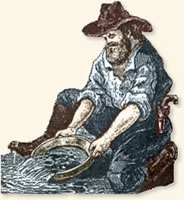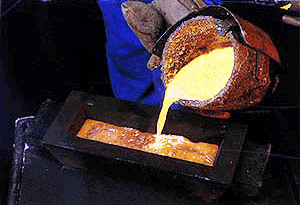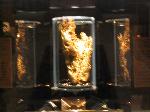Naturally occurring gold can be found in almost all fifty states. This gold may be still embedded in rock, known as "lode gold", or it may have been deposited in a placer (a natural concentration of gold particles in sand or gravel bars) after weathering from the host rock.
 Which streams contain gold? Generally speaking, streams that are most likely to contain gold must have four characteristics. They should be unregulated, not dammed. They should be in a mineral rich area. They should fall through enough elevation to cause sufficient churning in the spring flood. The stream path and rock formations should facilitate the deposition of the dense materials such as gold, lead, iron, and mercury. Which streams contain gold? Generally speaking, streams that are most likely to contain gold must have four characteristics. They should be unregulated, not dammed. They should be in a mineral rich area. They should fall through enough elevation to cause sufficient churning in the spring flood. The stream path and rock formations should facilitate the deposition of the dense materials such as gold, lead, iron, and mercury.
The trick is to find locations with enough gold to make it worthwhile to try to recover some of it. Prospecting in the better known gold bearing regions will immediately improve how your chances of finding gold are. Gold is where others have found it and you have come up with a better method of recovering gold.
 Gold occurs in veins and alluvial deposits, and is often separated from rocks and other minerals by mining and panning operations. About two thirds of the world's gold output comes from South Africa, and about two thirds of the total U.S. production comes from South Dakota and Nevada. Gold occurs in veins and alluvial deposits, and is often separated from rocks and other minerals by mining and panning operations. About two thirds of the world's gold output comes from South Africa, and about two thirds of the total U.S. production comes from South Dakota and Nevada.
The metal is recovered from its ores by cyaniding, amalgamating, and smelting processes. Refining is also frequently done by electrolysis. Gold occurs in sea water to the extent of 0.1 to 2 mg/ton, depending on the location where the sample is taken. As yet, no method has been found for recovering gold from sea water profitably.
All the shiny gold-colored material in you gold pan may not be gold. Pyrite, known as "fools gold," has fooled many before you. On close examination, however, pyrite does not really look like gold. Pyrite has a brassy color, is sometimes tarnished, and, because it occurs as crystals, changes shades as you rotate it in the sun. Gold is always gold colored, soft, and malleable or bendable. If you see gold-colored flecks that either float on the water or are so light in weight that they easily wash out of the pan, you probably have small pieces or "books" of mica, a mineral that because it is transparent and heat resistant was once used in doors of stoves so the fire could be seen. Mica has a tendency to break apart into flat sheets. It comes in several colors, and the the gold-colored variety is sometimes mistaken for gold by inexperiences gold panners.
 The world's largest gold nugget is on display at the Golden Nugget Hotel and Casino in Las Vegas, Nevada. The magnificent Hand of Faith Nugget gold nugget, found October, 1980 near Wedderburn, Australia, is the largest on public display in the world. Using a metal detector, it discovered lying in a vertical position just six inches below the surface. It weighs a massive 875 troy ounces (61 pounds, 11 ounces). The world's largest gold nugget is on display at the Golden Nugget Hotel and Casino in Las Vegas, Nevada. The magnificent Hand of Faith Nugget gold nugget, found October, 1980 near Wedderburn, Australia, is the largest on public display in the world. Using a metal detector, it discovered lying in a vertical position just six inches below the surface. It weighs a massive 875 troy ounces (61 pounds, 11 ounces).
The largest single mass of gold was found by Mr. Holtermann in Australia. His "nugget" as shown below was discovered at Hill End in 1872. The Holtermann Nugget remains the largest single mass of gold ever discovered in the world, measuring 1.5 metres long and weighing almost 290 kg.
Many a time, gold fever has caused an otherwise totally honorable and sensible man to give up his perfectly good woman, desert his devoted children, buy a devoted donkey, leave home, abandon good cropland, drink bad whiskey, waste good money, make disreputable friends, follow bad advice, ignore good advice, reveal secret gold strikes, pursue adventure, suffer hardship, and generally and perfectly unapologetically just go around having a shamelessly good time. |